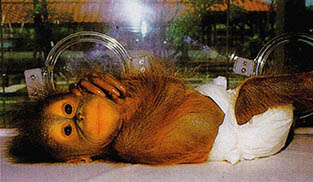Scientists have created the world’s first synthetic life form. It was a landmark experiment that paves the way for designer organisms that are built rather than evolved. The controversial feat has occupied 20 top-class scientists for more than 10 years at an estimated cost of 40 million dollars. And it was described by one researcher as ‘a defining moment of new paradigm in biology’.
Craig Venter, the U.S. scientist behind this experiment, said the achievement heralds the dawn of a new era - an era in which new life is made to benefit humanity, starting with bacteria that churn out biofuels, that soak up carbon dioxide from the atmosphere as a solution to the global warming, and that even manufacture vaccines.
However, critics including some religious groups, condemned the work, with one organization warning that artificial organisms could escape into the wild and cause environmental havoc or be turned into biological weapons. The new organism
is based on an existing bacterium that causes mastitis in goats. But at its core
is an entirely synthetic genome that was constructed from chemicals in the laboratory. The single-celled organism has four ‘watermarks’ written into its DNA to identify it as synthetic and help trace its descendants. “We were ecstatic when the cells booted up with all the watermarks in place”, Dr. Venter told the Guardian. “It’s a living species now, part of our planet’s inventory of life.”
Julian Savulescu, professor of practical ethics at Oxford University, said: “Dr. Venter is going towards the role of a god: creating artificial life that could never have existed naturally”. This early summer is “a defining moment in the history of biology and biotechnology”, Mark Bedau, a philosopher at Reed College in Portland, Oregon, told Science.
Dr. Venter became a controversial figure in the 1990’s when he pitted his former
company, Celera Genomics, against the publicly funded effort to sequence the human genome, the Human Genome Project. Venter had already applied for patents on more than 300 genes, raising concerns that the company might claim intellectual rights to the building blocks of life.
해석
최초의 인공 합성 생명체과학자들이 세계 최초의 인공 합성 생명체를 제조했다. 이는 자연적 진화가 아닌 인공적 제조를 통해 원하는 생명체를 만드는 가능성을 열어주는 기념비적인 실험이었다. 논란이 되고 있는 이 위업은 최고 수준의 과학자 20여명이 10년에 걸쳐 약 4000만 달러(한화 약 500억 원)의 연구비를 사용해 얻은 결과다. 그리고 한 연구자에 의하면 이것은 생물학에서 새로운 패러다임을 작성하는 순간이었다.
이 실험을 총괄한 미국 과학자 크레이그 벤터는 이 성취가 인류를 돕기 위해 새로운 생명체를 창조하는 새로운 시기가 도래했음을 뜻한다고 말했다. 이제는 생체연료를 제조하는 박테리아에서부터 (지구 온난화문제 해결을 위해) 대기 중 이산화탄소를 흡수하는 박테리아, 그리고 백신을 만드는 박테리아까지 만들 수 있는 시대가 왔다.
그러나 일부 종교계를 포함한 비판자들은 이 업적을 비난해 왔는데, 한 단체는 이러한 인공생명체가 자연계로 유출돼 환경재난을 초래하거나 생물학적 무기로 사용될 수 있다고 경고했다. 이 새로운 유기체는 염소에서 유선염을 만드는 박테리아에 기반해 제조됐다. 그러나 그 중심부에는 실험실에서 완전히 화학적으로 제조된 합성 유전체가 자리잡고 있다. 이 단세포 유기체는 DNA에 네 개의 워터마크를 갖고 있어서 그것이 합성된 개체임을 알려주며, 그 자손을 추적할 수 있도록 도와준다.
벤터 박사는 영국 가디언 지의 기자에게 말하기를 “세포들이 모든 워터마크를 제대로 갖춘 채 분열을 시작했을 때 너무나도 기뻤다”고 밝혔다. 또 그는 “이제 이것들은 살아있는 종(種)이며 우리 행성의 생명체 중 하나라고 볼 수 있다”고 덧붙였다.
옥스퍼드 대학의 실천윤리학 교수 줄리앙 새뷸레스크는, “벤터 박사가 단순히 생명체를 인공적으로 모방하는 것도 아니고 유전공학으로 생명체를 과격하게 조작하고 있는 것도 아니다. 자연적으로는 존재할 수 없었던 인공생명을 만들어 신의 역할에 가깝게 다가서고 있는 것이다”라고 말한다.
미 오리건주 포트랜드에 위치한 리드 대학의 철학자 마크 비도우는 사이언스 지와의 인터뷰에서 인공 생명체가 창조된 2010년 초여름 현재가 “생물학과 생명공학의 역사를 새롭게 정의하는 순간이다”라고 말했다.
벤터 박사는 1990년도에 이미 셀레라 제노믹스라는 회사를 설립해 논쟁의 중심에 섰던 인물이다. 당시 셀레라 제노믹스는 공공기금으로 운영되던 인간게놈프로젝트(HGP)과 경쟁하기 위해 설립된 회사다. 벤터는 이미 300개 이상의 유전자에 대해 특허를 신청한 상태며, 그의 회사가 생명을 형성하는 기본 단위체인 유전자에 대한 지적 소유권을 주장하는 것이 아닌가 하는 우려를 낳고 있다.
Craig Venter, the U.S. scientist behind this experiment, said the achievement heralds the dawn of a new era - an era in which new life is made to benefit humanity, starting with bacteria that churn out biofuels, that soak up carbon dioxide from the atmosphere as a solution to the global warming, and that even manufacture vaccines.
However, critics including some religious groups, condemned the work, with one organization warning that artificial organisms could escape into the wild and cause environmental havoc or be turned into biological weapons. The new organism
is based on an existing bacterium that causes mastitis in goats. But at its core
is an entirely synthetic genome that was constructed from chemicals in the laboratory. The single-celled organism has four ‘watermarks’ written into its DNA to identify it as synthetic and help trace its descendants. “We were ecstatic when the cells booted up with all the watermarks in place”, Dr. Venter told the Guardian. “It’s a living species now, part of our planet’s inventory of life.”
Julian Savulescu, professor of practical ethics at Oxford University, said: “Dr. Venter is going towards the role of a god: creating artificial life that could never have existed naturally”. This early summer is “a defining moment in the history of biology and biotechnology”, Mark Bedau, a philosopher at Reed College in Portland, Oregon, told Science.
Dr. Venter became a controversial figure in the 1990’s when he pitted his former
company, Celera Genomics, against the publicly funded effort to sequence the human genome, the Human Genome Project. Venter had already applied for patents on more than 300 genes, raising concerns that the company might claim intellectual rights to the building blocks of life.
해석
최초의 인공 합성 생명체과학자들이 세계 최초의 인공 합성 생명체를 제조했다. 이는 자연적 진화가 아닌 인공적 제조를 통해 원하는 생명체를 만드는 가능성을 열어주는 기념비적인 실험이었다. 논란이 되고 있는 이 위업은 최고 수준의 과학자 20여명이 10년에 걸쳐 약 4000만 달러(한화 약 500억 원)의 연구비를 사용해 얻은 결과다. 그리고 한 연구자에 의하면 이것은 생물학에서 새로운 패러다임을 작성하는 순간이었다.
이 실험을 총괄한 미국 과학자 크레이그 벤터는 이 성취가 인류를 돕기 위해 새로운 생명체를 창조하는 새로운 시기가 도래했음을 뜻한다고 말했다. 이제는 생체연료를 제조하는 박테리아에서부터 (지구 온난화문제 해결을 위해) 대기 중 이산화탄소를 흡수하는 박테리아, 그리고 백신을 만드는 박테리아까지 만들 수 있는 시대가 왔다.
그러나 일부 종교계를 포함한 비판자들은 이 업적을 비난해 왔는데, 한 단체는 이러한 인공생명체가 자연계로 유출돼 환경재난을 초래하거나 생물학적 무기로 사용될 수 있다고 경고했다. 이 새로운 유기체는 염소에서 유선염을 만드는 박테리아에 기반해 제조됐다. 그러나 그 중심부에는 실험실에서 완전히 화학적으로 제조된 합성 유전체가 자리잡고 있다. 이 단세포 유기체는 DNA에 네 개의 워터마크를 갖고 있어서 그것이 합성된 개체임을 알려주며, 그 자손을 추적할 수 있도록 도와준다.
벤터 박사는 영국 가디언 지의 기자에게 말하기를 “세포들이 모든 워터마크를 제대로 갖춘 채 분열을 시작했을 때 너무나도 기뻤다”고 밝혔다. 또 그는 “이제 이것들은 살아있는 종(種)이며 우리 행성의 생명체 중 하나라고 볼 수 있다”고 덧붙였다.
옥스퍼드 대학의 실천윤리학 교수 줄리앙 새뷸레스크는, “벤터 박사가 단순히 생명체를 인공적으로 모방하는 것도 아니고 유전공학으로 생명체를 과격하게 조작하고 있는 것도 아니다. 자연적으로는 존재할 수 없었던 인공생명을 만들어 신의 역할에 가깝게 다가서고 있는 것이다”라고 말한다.
미 오리건주 포트랜드에 위치한 리드 대학의 철학자 마크 비도우는 사이언스 지와의 인터뷰에서 인공 생명체가 창조된 2010년 초여름 현재가 “생물학과 생명공학의 역사를 새롭게 정의하는 순간이다”라고 말했다.
벤터 박사는 1990년도에 이미 셀레라 제노믹스라는 회사를 설립해 논쟁의 중심에 섰던 인물이다. 당시 셀레라 제노믹스는 공공기금으로 운영되던 인간게놈프로젝트(HGP)과 경쟁하기 위해 설립된 회사다. 벤터는 이미 300개 이상의 유전자에 대해 특허를 신청한 상태며, 그의 회사가 생명을 형성하는 기본 단위체인 유전자에 대한 지적 소유권을 주장하는 것이 아닌가 하는 우려를 낳고 있다.

















